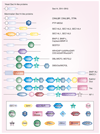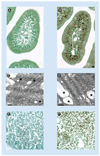Mammalian diseases of phosphatidylinositol transfer proteins and their homologs
- PMID: 21603057
- PMCID: PMC3097519
- DOI: 10.2217/clp.10.67
Mammalian diseases of phosphatidylinositol transfer proteins and their homologs
Abstract
Inositol and phosphoinositide signaling pathways represent major regulatory systems in eukaryotes. The physiological importance of these pathways is amply demonstrated by the variety of diseases that involve derangements in individual steps in inositide and phosphoinositide production and degradation. These diseases include numerous cancers, lipodystrophies and neurological syndromes. Phosphatidylinositol transfer proteins (PITPs) are emerging as fascinating regulators of phosphoinositide metabolism. Recent advances identify PITPs (and PITP-like proteins) to be coincidence detectors, which spatially and temporally coordinate the activities of diverse aspects of the cellular lipid metabolome with phosphoinositide signaling. These insights are providing new ideas regarding mechanisms of inherited mammalian diseases associated with derangements in the activities of PITPs and PITP-like proteins.
Figures







References
Bibliography
-
- Michell RH. Inositol derivatives: evolution and functions. Nat. Rev. Mol. Biol. 2008;9:151–161. - PubMed
-
- Fruman DA, Meyers RE, Cantley LC. Phosphoinositide kinases. Annu. Rev. Biochem. 1998;67:481–507. - PubMed
-
- Di Paolo G, De Camilli P. Phosphoinositides in cell regulation and membrane dynamics. Nature. 2006;443:651–657. - PubMed
Website
-
- The Scripps Research Institute – Mutagenetix home page. http://mutagenetix.scripps.edu/home.cfm.
Grants and funding
LinkOut - more resources
Full Text Sources
